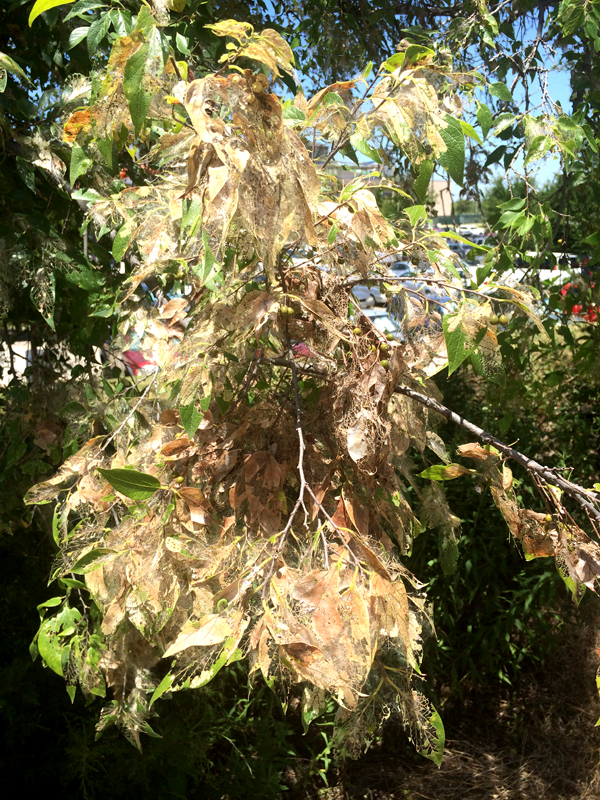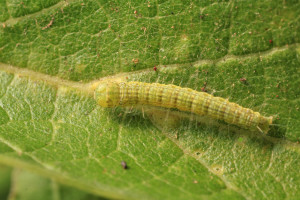
Webbing and defoliation on sugarberry hackberry by the moth Sciota celtidella. Photo by Courtney Blevins.
Over the past few weeks I’ve had several emails concerning a small caterpillar infesting hackberry in the Flowermound and Grapevine, TX area especially. After some initial head scratching over fuzzy pictures sent via email, my lab employees went caterpillar hunting yesterday and brought back a good haul of larvae feeding on sugarberry trees, Celtis laevigata.
After sending pictures to colleagues, James McDermott of College Station identified the critters as Sciota celtidella, an obscure moth that has been recorded feeding on hackberry, Celtis occidentalis (Alma Solis, Bull. Biolog. Soc. of WA May 2008: 88-106).
So why should a little moth that’s rarely seen or collected suddenly become such a pest? It is not uncommon for insects to go from extreme obscurity to being incredibly abundant over sometimes a very small area. This was pointed out to me by Austin entomologist Val Bugh, who maintains an interesting website and whose avocation is looking for obscure insects. Chances are that this year will prove an anomaly, and hackberries will happily grow undisturbed next year. But no one knows. These little surprises are part of what keeps entomology interesting.
If your yard or local hackberry fence line is turning brown right now from these caterpillars, you may choose to treat or let nature take its course. Untreated trees will not likely re-leaf this far into the season. But if the trees are otherwise healthy, they will most likely be fine next spring. If you want to preserve the remaining foliage on your hackberry tree, treating with spinosad or a pyrethroid insecticide should stop the infestation quickly.
Note that like many insects, these caterpillars are very host specific. Infestations will remain only on sugarberry or hackberry trees, and will not move on to other landscape plants or trees.
Hackberries, like most trees in north Texas, are under some stress from a long, hot summer, as well as previous years’ drought. So if your tree has been affected by caterpillar feeding, consider the following tree care suggestions from tree experts:
- If your soil is very dry, supplemental deep watering around the base of trees can help a tree through late summer stress.
- Most shade trees do not need special fertilization, however you can apply compost and mulch around the base of the tree. Ask an arborist whether your tree might benefit from root feeding–this often requires a soil test.
- For trees in lawns with compacted soil, aeration of the lawn can help the tree better absorb water and nutrients.
If you see this insect defoliating trees outside the Lake Grapevine area, I would be interested to know. You can find my email address here.
